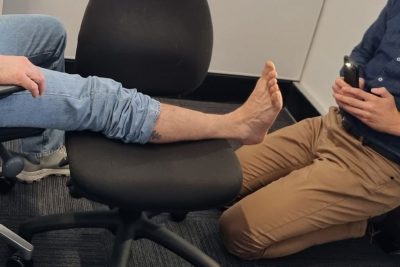Breakthrough for diabetes foot ulcer sufferers in the form of an app
For people with diabetes, diabetes foot ulcers (DFU) can be a distressing yet common complication that can result in many hospitalisations and amputations for sufferers without good treatment.

The new MyFootCare app is helping patients with better self-care of their diabetic foot ulcers at home.
To prevent these devastating hospitalisations and amputations, patients typically need weekly treatment by doctors, nurses and podiatrists working together in multi-disciplinary foot clinics.
Yet, clinicians and researchers at The Prince Charles Hospital (TPCH) and Queensland University of Technology observed most DFU treatment is performed by the patient or carer at home in the form of self-care, such as checking, changing dressings, and using offloading boots.
“We know diabetes foot disease is a very serious global health problem and there are now around 200 million people worldwide with some form of it,” Associate Professor Peter Lazzarini said.
“In fact, every day in Australia alone, we estimate 50,000 people have a DFU, 1,000 will be in hospital because of it and 12 will need an amputation.
“We know if people with DFU can get good treatment from their health professionals, we can halve their chance of needing hospitalisation or amputation and, if patients are able to perform good self-care at home, we can halve that chance again.”
People with DFU often have multiple impairments which can make performing self-care very challenging, such as poor mobility, vision, and sensation so the team identified the requirement for simpler ways to perform this self-care.
In response, the research team in partnership with patients and clinicians developed a new mobile phone app, called MyFootCare. While there were existing apps designed for use by healthcare professionals, this app was the first to be designed by patients for patients to help them with their DFU self-care at home.
The app contains multiple enabling features, such as goal setting, voice-activated image capture, analytics to monitor DFU progress and self-care notifications.
“This app enables patients to use their smartphone to take a photo or “selfie” of their foot with voice activity controls and upload it to the app,” Assoc Prof Lazzarini said.
“Visual analytics within the app then help patients automatically measure the DFU, monitor symptoms and track DFU healing objectively, and it flags when things are getting better or worse to the patient and potentially clinical team.”
The research team has just completed a study funded by TPCH Foundation to evaluate the feasibility, acceptability, and actual use of the app over three months by patients.
“We found nearly all patients thought the app was a very valuable way to monitor their DFU progress, help them self-care and enhance their communication with their health professionals,” Assoc Prof Lazzarini said.
The next steps are now to trial the app in people used to using smartphones regularly to determine if the app improves their self-care over time, helps heal their DFU quicker, and prevents hospitalisations and amputations.
“We hope this technology becomes a simple way to help sufferers with DFU improve their care, health and reduce this very serious global health problem,” Assoc Prof Lazzarini said.
